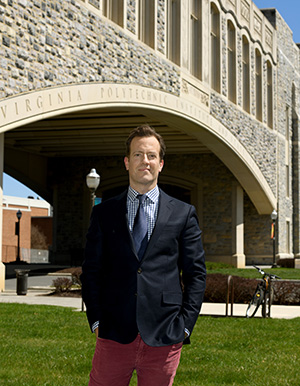The Prophet
MicroStrategy’s Michael Saylor preaches the bitcoin gospel. Will his $2.2 billion gambit reap a heavenly reward?
Rich Griset //April 29, 2021//
The Prophet
MicroStrategy’s Michael Saylor preaches the bitcoin gospel. Will his $2.2 billion gambit reap a heavenly reward?
Rich Griset //April 29, 2021//
When Michael Saylor was a younger man, his good looks and cocky attitude drew comparisons to Tom Cruise.
And like Capt. Pete “Maverick” Mitchell, Cruise’s flying ace of “Top Gun” fame, Saylor is returning to screens everywhere after a decades long hiatus.
Just over 20 years ago, Saylor was Northern Virginia’s premier hotshot tech exec. Dubbed the wealthiest man in the Washington, D.C., region by Washingtonian magazine at the time, he was interviewed by “60 Minutes” and Charlie Rose and made People magazine’s Most Eligible Bachelors list in 2000.
But these days the chairman and CEO of Tysons-based business intelligence and software company MicroStrategy Inc. is better known as bitcoin’s chief cheerleader — a cryptocurrency evangelist with more than 750,000 Twitter followers.
Appearing in national media from Time magazine to CNBC, Saylor preaches that the central banks are propping up the economy with cheap money, that cash is trash and bitcoin will be our salvation.
“Bitcoin is a bank in cyberspace for people that don’t have the ability to run their own hedge fund. It’s not a stock — it’s an asset class,” Saylor told CNBC in February, interviewed from his Miami mansion.
Saylor isn’t afraid to put his bitcoin where his mouth is. A longtime, well-known player in the Northern Virginia tech industry, Saylor has raised his profile to an entirely new level since last August, when his company announced it had begun acquiring bitcoin with its cash reserves in a move that some view as a gamble, but others see as prescient.
During the past nine months, under Saylor’s direction, MicroStrategy, a 2,000-employee, publicly traded
company with 4,000 corporate customers internationally, has spent more than $2.2 billion acquiring bitcoin; as of April 14, MicroStrategy’s investment was worth $5.94 billion. Last month, Bloomberg predicted that bitcoin, which reached an all-time high price of $64,829 per coin in April, could skyrocket as high as $400,000 per coin by the end of this year.
For the cryptocurrency faithful, Saylor is the prophet they’ve been looking for, even supposedly influencing Tesla Inc.’s decision to invest $1.5 billion in bitcoin through his exchange with Elon Musk.
An inventor, author and philanthropist, Saylor has said, “The destiny of money is to be encrypted.” (MicroStrategy and Saylor did not respond to multiple requests for interviews for this story.)
As brilliant as Saylor is said to be, many traditional finance experts are wary of bitcoin, cautioning that it’s volatile, unregulated and untethered to any actual value.

There’s also reason to be skeptical of Saylor.
Twenty-one years ago, Saylor’s house of floppy disks nearly collapsed when his company had to restate two years of inaccurate financial statements, leading to accusations of fraud by the U.S. Securities and Exchange Commission. According to Fortune magazine, MicroStrategy’s stock lost 98% of its value in barely two years’ time.
Though Saylor and MicroStrategy settled the SEC’s civil charges without admitting wrongdoing, the restatement of MicroStrategy’s financial reporting led to such a decline in the company’s stock value that Saylor’s net worth fell by $6.1 billion in a single day in 2000. It made him the answer to a Trivial Pursuit 20th Anniversary Edition card: “Who has lost the most money in a single day?”
MicroStrategy didn’t collapse like Pets.com, but its fall from grace was one of the biggest nosedives of the dotcom bubble burst. “This one popped the bubble,” wrote a pre-”Mad Money” Jim Cramer in a column that year. “MicroStrategy was the No. 1 item that caused the horrific selloff in the higher-valued technology names.” Fortune magazine called Saylor — whose personal net worth on paper fell by $13.54 billion at the time — the “biggest loser” of the era’s tech bubble.
Is Michael Saylor a visionary who sees that we’re facing the dawn of the cryptocurrency era? Or could Saylor be wrong and lose a fortune, just as he did two decades ago?
Or are both possible futures for the man who appears to have a need for speed?
The bet
With his company’s cash reserves piling up amid lowered company expenses during the pandemic, Saylor announced last summer that his company would be going long on bitcoin.
“MicroStrategy has recognized bitcoin as a legitimate investment asset that can be superior to cash and accordingly has made bitcoin the principal holding in its treasury reserve strategy,” Saylor said in a statement at the time. “Bitcoin is digital gold — harder, stronger, faster and smarter than any money that has preceded it. We expect its value to accrete with advances in technology, expanding adoption and the network effect that has fueled the rise of so many category killers in the modern era.”
MicroStrategy started its bitcoin buying spree last summer, announcing in August 2020 it had acquired 21,000 bitcoins for $250 million. A month later, the company announced it had bought nearly 17,000 more bitcoins for $175 million. Then, in December 2020, MicroStrategy raised $650 million through a convertible debt offering to buy bitcoin. In February, the company announced it had purchased an additional $1.026 billion in bitcoin after completing two convertible debt offerings to raise capital to finance additional purchases of the cryptocurrency. It continued buying bitcoin in March and April, paying $30 million.
Between July 2020 and early April, MicroStrategy paid more than $2.2 billion for bitcoin. As of April 5, the company held a total of 91,579 bitcoin, for which it paid an average of $24,311 per coin, according to a company SEC filing.
Based on an April 14 bitcoin price of $64,829, MicroStrategy’s virtual bitcoin treasure chest was worth about $5.94 billion that day — a 170% increase on the company’s investment. According to a February SEC filing, MicroStrategy ended 2020 with $1.465 billion in assets and $480.7 million in annual revenue.
Saylor believes bitcoin is a way to protect his company’s money from inflation, that bitcoin will skyrocket to 100 times its present value and is superior to gold as a store of value. He’s been bitcoin’s biggest advocate in interviews with national media and the cryptocurrency blogosphere.
“Bitcoin is the most widely held investment asset in the world right now,” he told CNBC in February. “We have congressmen, we have senators, we have members of government, we have CEOs.”
After announcing MicroStrategy’s $1 billion purchase in February, Saylor told Bloomberg he was considering issuing more debt to buy additional bitcoin. “We’ve been pretty clear that we’ll consider equity and debt financings” in order to buy more bitcoin, he said. “It makes sense to buy as much of that asset class as we can.”
In a March interview with Time, Saylor called Tesla’s bitcoin investment “an inflection point. All of a sudden, the narrative goes from ‘Those crazy people, what are they thinking, speculating in bitcoin?’ to ‘Maybe this is a real thing. This is probably not going away.’”
Twitter is also part of his boosterism. Under a photo of himself with laser eyes, Saylor’s account has a pinned tweet reading that bitcoin “is a swarm of cyber hornets serving the goddess of wisdom, feeding on the fire of truth, exponentially growing ever smarter, faster, and stronger behind a wall of encrypted energy.”
Since MicroStrategy began buying up bitcoin, the currency has become increasingly mainstream. On April 14, Coinbase Global Inc. became the first major crypto business to go public, briefly reaching a $110 billion market cap. Also in April, the total value of the cryptocurrency market passed $2 trillion, with bitcoin making up half of that.
Saylor’s bullishness on bitcoin has been a boon for MicroStrategy. Since the company began purchasing bitcoin in August 2020, bitcoin’s price has surged more than 400% and MicroStrategy’s stock has gained 534.3% in the past 12 months. Saylor’s own stock in the company was worth roughly $1.5 billion as of mid-April; he also says he personally holds nearly 18,000 bitcoin, which was worth more than $1 billion.
According to SEC filings, MicroStrategy President and Chief Financial Officer Phong Le has sold more than $25 million in company stock since November 2020. MicroStrategy board members and another executive also have netted millions from exercising stock options. Additionally, MicroStrategy has elected to pay non-employees on its board of directors in bitcoin, according to an April SEC filing.
Is this just a way for Saylor to enrich himself, his MicroStrategy investors and colleagues and return to a relevancy he hasn’t enjoyed in two decades? Michael Beckley, a former MicroStrategy employee who’s known Saylor for 25 years, doesn’t think so.
“The company is him. His identity is MicroStrategy. This is his life’s work, and he’s gambling it all on bitcoin,” says Beckley, co-founder and chief technology officer of McLean-based cloud computing and software company Appian Corp. “This is not a startup gambling on bitcoin. This is his entire career.”
Have space suit — will travel

The bra buyers of New York City prefer their lingerie in black. The women of Miami? White brassieres, thank you very much. And, in the Midwest, larger-size bras fly off the shelves faster than in other parts of the country.
To most people, this information is useless trivia. But for Victoria’s Secret, this data revolutionized the way it stocked its stores. And the undergarment titan had MicroStrategy to thank for those insights.
Founded in 1989, MicroStrategy was an early data mining firm. Though big
corporations were collecting massive amounts of information about customers’ shopping tastes, the science of taking this raw data and turning it into workable information was still in its infancy. MicroStrategy became known for providing data mining services to companies such as Victoria’s Secret, McDonald’s Corp. and Nissan Motor Corp.
But to truly understand MicroStrategy, you must first understand the founder who shares the company’s initials.
The son of a U.S. Air Force chief master sergeant, Saylor grew up on air bases around the globe before his family settled in Fairborn, Ohio, when he was 11. At 6 a.m., his father would wake him with a loud clap, shouting, “Hit the floor running, son!”
A voracious reader of science fiction and histories of ancient Rome, Saylor was inspired by Robert A. Heinlein’s “Have Space Suit — Will Travel” to attend MIT on an ROTC scholarship, with hopes of becoming an Air Force pilot and astronaut. A heart murmur prevented him from pursuing a career as an Air Force pilot, but he double majored at MIT, obtaining degrees in aeronautics and astronautics; and science, technology and society.
“He was very focused and smart, obviously,” says John Sterman, a professor of management at MIT’s business school and Saylor’s thesis adviser. “Really focused and really sincere about understanding what he was doing, and how it could be applicable and useful in the real world.”
At age 24, Saylor co-founded MicroStrategy in 1989 with his MIT roommate and fraternity brother Sanju Bansal.
Beckley, who was recruited by MicroStrategy while finishing his undergraduate degree at Dartmouth College, doesn’t mince words about his introduction to Saylor in 1996.
“I hated him,” says Beckley, who has a different take on that first interaction in hindsight, saying he now considers Saylor a friend: “When two arrogant, high-performing people … first meet, it’s not necessarily kismet.”
Back then, MicroStrategy was still in startup mode, with about 350 employees. The company was compared to a cult by the likes of The Washington Post and other media outlets for its employees’ devotion to Saylor, his lectures that could last eight hours and Saylor’s penchant for listing historical figures such as Julius Caesar, Winston Churchill and Mahatma Gandhi as his role models. Once a year, Saylor would take his entire company on a cruise, no spouses allowed.
“Definitely not a cult,” says Beckley, adding that people focus too much on Saylor’s tendency toward hyperbole. “MicroStrategy was a founder-led company, so what Mike said mattered a lot, and there were people who definitely idolized him, but it was the ’90s. It was a party atmosphere. The cliché of work hard, play hard was very true at MicroStrategy. It was very results-driven, very quantitative — just like you’d expect some MIT people to create.”
Beckley, who left to co-found Appian with fellow MicroStrategy alum Matt Calkins in 1999, learned many lessons from Saylor. “[MicroStrategy] didn’t have outside funding. We had to learn and do everything on the cheap, and you had to do it yourself,” he says. “It was the best MBA program in the world, bar none.”
In the late 1990s and early 2000s, Saylor frequently appeared in the national press. (He was the subject of a four-part series by The Washington Post in 2002.) He dined with then-U.S. Sen. John Kerry and wife Teresa Heinz at their home and received multiple invitations to the White House.
Saylor has also been a confidant of U.S. Sen. Mark Warner. Warner’s office declined to divulge details of their relationship but released this statement from Virginia’s senior senator, himself a former tech entrepreneur: “I’ve known Michael for more than 20 years. He is extraordinarily bright, creative and always able to look at an issue and see a new and unique angle.”
During his 35th birthday party in February 2000, Saylor said he was going to run for president and would nominate Bansal as his vice president and high-tech venture capitalist Russ Ramsey as his treasury secretary.

“Who knows if Mike was kidding, per se?” says Ramsey, chairman and CEO of McLean-based Ramsey Asset Management LLC and a past chair of the Greater Washington Partnership. “That was a fun, fun night, but I don’t think I’ll be treasury secretary, and I doubt he’ll be running for president.”
At the time, MicroStrategy was going gangbusters. Saylor and his company were churning out new ideas, products and spinoffs like its former subsidiary Alarm.com, which offers web-based security and monitoring systems to residential and commercial customers. MicroStrategy even aired national television commercials during the 2000 Super Bowl.
According to a Washingtonian profile, MicroStrategy’s stock rose 47 points in a single day in 1999, raising Saylor’s personal worth on paper by $1 billion, to a total of $7 billion. By comparison, AOL co-founder, CEO and Chairman Steve Case was worth about $1 billion at the time.
Saylor “was the wealthiest tech entrepreneur, and his company was one of the most valuable, if not the most valuable” in the D.C. area, Ramsey says.
He even found time to create a nonprofit tuition-free online college: Saylor Academy. (The Washington Post previewed his plan for the institution on its front page in 2000.) Through his charitable foundations, Saylor has supported educational, youth and health charities as well as local arts and culture mainstays such as Wolf Trap National Park for the Performing Arts, The Washington Ballet and The John F. Kennedy Center for the Performing Arts.
But for a man who has measured himself against the ancients, Saylor has also drawn comparisons to the myth of Icarus and Daedalus.
When MicroStrategy went public in 1998 — orchestrated by Ramsey — the company doubled in value its first day. But on March 20, 2000, after reviewing its accounting practices, MicroStrategy announced it would restate its financial results from the previous two fiscal years in order to comply with federal accounting guidelines. This resulted in the company reporting net losses for those years instead of the positive net income it previously reported. In a single day, the company lost more than 60% of its value. By the end of 2000, the SEC brought civil charges against the company and its executives, alleging an accounting scheme to make the money-losing corporation appear profitable.
Though Saylor, other executives and the company settled for a collective $11 million without admitting wrongdoing, MicroStrategy never fully regained its footing as the high-flying corporation it once was. Following the restatement, MicroStrategy’s stock plummeted from an all-time peak of $3,130 a share to roughly $50 to $200 per share during the period from 2000 to fall 2020.
“It was chaos, it was scary, it was sad,” recalls Beckley, who left in 1999 to form Appian. “You’d get reports of Mike just going for long hikes in Great Falls [Park]. People would see him on the trail. We were all terrified, worried. What would he do? Would MicroStrategy survive? Would he survive?”
Though Saylor and the company made it through the challenging period, MicroStrategy never returned to its former prominence. In Beckley’s view, Saylor’s embrace of bitcoin came out of the desire for his company to take a bold action.
MicroStrategy is “not leading the analytics space,” opines Beckley. “They’re not relevant in terms of defining where software’s going, and so he didn’t see a lot of great options, but he had this incredible asset, which was a lot of cash, and an asset he could borrow against to get more. Talk about belief. When you leverage yourself into an idea like that, that’s pure Mike.”
These days, MicroStrategy is embracing two corporate strategies, as outlined in a February SEC filing: enterprise analytics software and bitcoin. Regarding the former, MicroStrategy is undergoing a shift from a product licensing model to a cloud-based subscription model for its business analytics software. As for the latter, the filing states that regulatory, commercial and technical factors related to the price of bitcoin could “significantly influence” the price of the company’s stock.
MicroStrategy’s bitcoin bet saw the company’s stock rise as high as $1,272.94 in early February; it was trading at $882.10 on April 14, up from roughly $126 per share during the same period a year earlier.
Releasing the Kraken

Though he’s fascinated by Saylor’s bet on bitcoin, David Bieri offers a blunt opinion of investing in the cryptocurrency: “Will it all end in tears? The short answer, to me, is ‘Yes.’”
An associate professor of economics at Virginia Tech, Bieri spent a decade working in international finance before turning to academia, where he specializes in regional economics, public finance and economic geography.
The rise of cryptocurrencies can be traced to the Great Recession and the late-2000s financial bailouts that followed, Bieri says. With the pandemic’s further erosion of public confidence in the state and traditional financial systems, Bieri says, cryptocurrency is one way people are trying “to stick it” to central authority. He cites this January’s short squeeze of GameStop Corp. stock orchestrated by users of the Reddit forum WallStreetBets as another example.
“It’s a crisis in some ways. The rise of bitcoin I view as something that has to do with a lack of confidence in the current regime,” says Bieri, the organizer of Virginia Tech’s annual “Blocksburg” blockchain symposium. (Blockchain is the record-keeping technology behind bitcoin.)
Against an ideological backdrop that has many bitcoin proponents labeling themselves crypto-libertarians and calling for money to be divorced from the state, Bieri sees a similar streak in Saylor. “He speaks openly about how the Fed has been engaging in an inflationary policy, and if you held things in cash, he would essentially be giving money away because it’s being inflated away,” Bieri says.
With cryptocurrencies, the aim is to create a stateless, trust-based form of money. In the case of bitcoin, that assurance comes from blockchain — databases that are linked together to form a secure ledger of transactions.
Bieri, however, says “it’s very much possible” that blockchain could be hacked, and that quantum computers — a future generation of computers currently in development that will dwarf the abilities of current supercomputers — pose an existential threat to blockchain; many experts believe widespread adoption of quantum computers is decades away, though.
“Saylor never talks about the underlying technology,” Bieri says. “He just takes it as given.”
As for investing in bitcoin, Bieri warns that the cryptocurrency is “very prone to crises and bubbles,” that “there is no intrinsic value to bitcoin.
“No other asset that has ever been a store of value has been so volatile, not even gold,” Bieri adds, noting that bitcoin collapsed in 2018, falling 81% from its one-time peak about a year earlier. Why? “No one can explain it. Now we have an even bigger bubble, but nothing prevents it from going back to zero again.” (During the weekend of April 17-18, fueled in part by Twitter rumors that the U.S. Treasury Department was going to take action against financial institutions related to cryptocurrencies, bitcoin’s price fell to $52,149, a 24.3% drop from its $64,829 apex earlier that week.)
In February, U.S. Treasury Secretary Janet Yellen warned that bitcoin represents a danger to both investors and the public at large. In March, Federal Reserve Chairman Jerome Powell stated that cryptocurrencies are a highly volatile and unstable store of value.
On March 29, HSBC Holdings plc, Europe’s largest bank, announced it would ban customers of its online share-trading platform from buying or moving MicroStrategy stock, calling it a “virtual currency product.”
Still, bitcoin has its fans.
Last month, Bloomberg published a report predicting that bitcoin could approach $400,000 per coin by the end of this year. In its monthly “Crypto Outlook” report, Bloomberg stated that bitcoin’s history in comparison to factors like liquidity and volatility meant that the “technical outlook for bitcoin in 2021 remains strongly upward, if past patterns repeat” and that it may replace “gold as the global digital-reserve asset.”
Many other analysts also offer positive — but far less dramatic — forecasts, predicting that bitcoin will rise to roughly $100,000 per coin this year.
Edward Moya, a New York City-based senior market analyst for currency trading firm Oanda Corp., is bullish on bitcoin. With more institutional players jumping on the crypto bandwagon, Moya says, bitcoin’s volatility is waning. He also expects the per coin price to reach $100,000 by the end of 2021.
“As long as we keep seeing corporate America embrace cryptos, you’re probably going to see [bitcoin] prices climb higher.”
Still, Moya warns that “there’s a tremendous amount of risk still in place” — that regulatory scrutiny could pick up, that rival cryptocurrencies such as Ethereum are gaining traction, and that with Coinbase going public and its rival Kraken making plans to follow, the outlook for bitcoin and MicroStrategy may become problematic.
Once bitcoin surpasses $75,000 a coin, MicroStrategy’s stock will likely grow to $900 a share, Moya says, but the company may need to diversify if it wants to be viewed more favorably by Wall Street.
“What’s complicating the outlook for MicroStrategy is their core software business is nothing to brag about,” he says. And if bitcoin strongly outperforms MicroStrategy, some may question whether it makes more sense to purchase bitcoin directly instead of MicroStrategy’s stock.
Still, Moya lauds Saylor for his approach.
“You can’t argue against their strategy right now, because it has been working,” he says. “He’s been right about bitcoin. He’s been right about how it evolves.”
Should bitcoin have another meltdown, though, Moya says, it would be hard for MicroStrategy to recover.
“That would really destroy [MicroStrategy]. Whatever few ‘buy’ ratings they have would go to ‘sell,’” Moya says. “It would be extremely difficult for the company to bounce back from that.”
Need for speed
In recent months, some of the finance world’s traditional players also have started getting in on the cryptocurrency action.
Bank of New York Mellon Corp., America’s oldest bank, has said it will begin financing bitcoin and other digital currencies. This year, New York-based Goldman Sachs Group Inc., New York-based Morgan Stanley, California-based Visa Inc., Boston-based investment giant Fidelity Investments Inc. and California’s PayPal Holdings Inc. have all announced the embrace of products and transactions using bitcoin or other cryptocurrencies.
Asked about these developments, Bieri stresses that there’s a fundamental difference between bitcoin and other cryptocurrencies, and that stablecoin —
a term for cryptocurrencies that attempt to minimize their volatility by wedding themselves to a “stable” asset like the U.S. dollar — may find wider success, he says.
“Bitcoin is going through a classic financial asset bubble. We’ve seen those. We know how those end,” Bieri says. “What’s new about this is its scale, its global reach.”
And now digital currencies are also aiming to become major players on the world stage. Early next year, China’s central bank aims to launch a digital currency with the eventual goal of replacing its paper money and coins. Similarly, the Federal Reserve has said it is studying the feasibility of creating a U.S. digital currency.
These developments probably don’t surprise Saylor, who predicted as early as 2012 that cash as we know it would disappear.
As for why and how Saylor has become bitcoin’s evangelist, Beckley, his longtime friend, has some thoughts.
“Mike is driven by ideas, and he feels like if he isn’t out there making them come to life, they won’t happen. He definitely puts himself at the center of the universe as this prime mover, and he has to be relevant. It’s like an itch he can’t scratch,” says Beckley, whose childhood hopes of attending the U.S. Naval Academy were similarly dashed because of a heart condition.
“He’s the kid who wanted to be an Air Force pilot and was sidelined by a heart murmur, and I think that need, that urgency to go fast, above it all, and push the boundaries of human existence — I get that, and I think it’s how [he’s] programmed.”

















